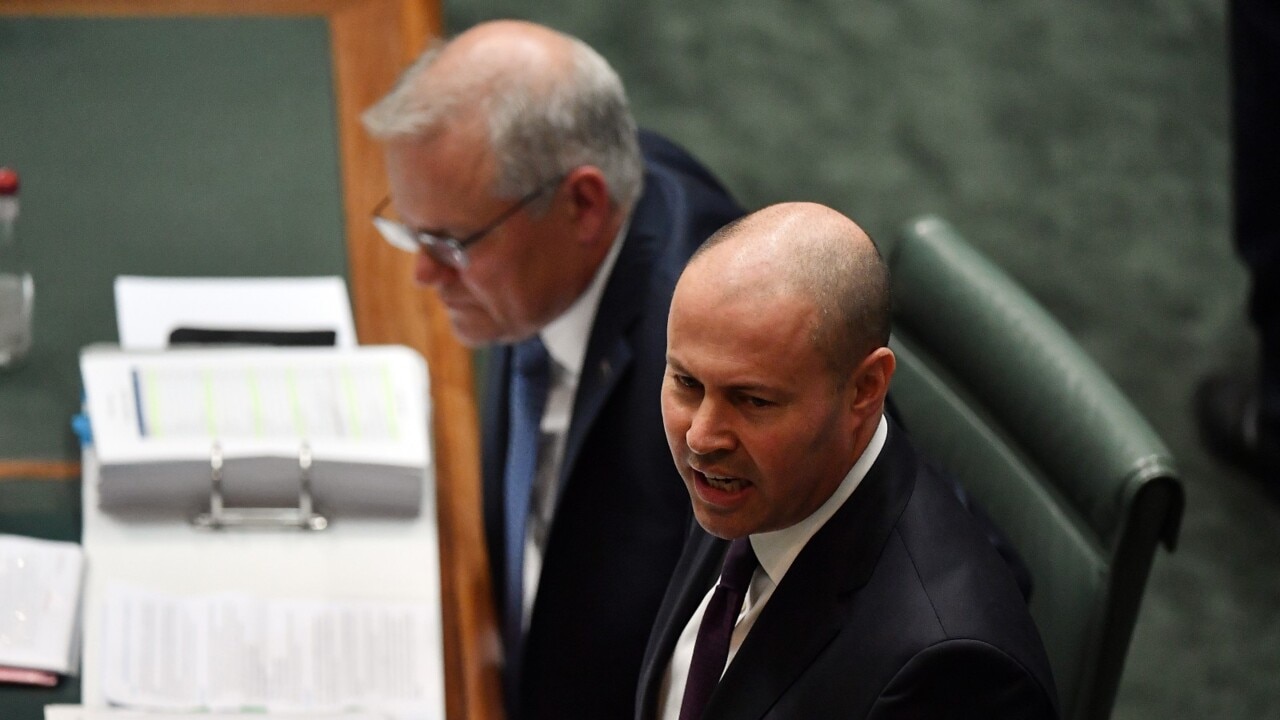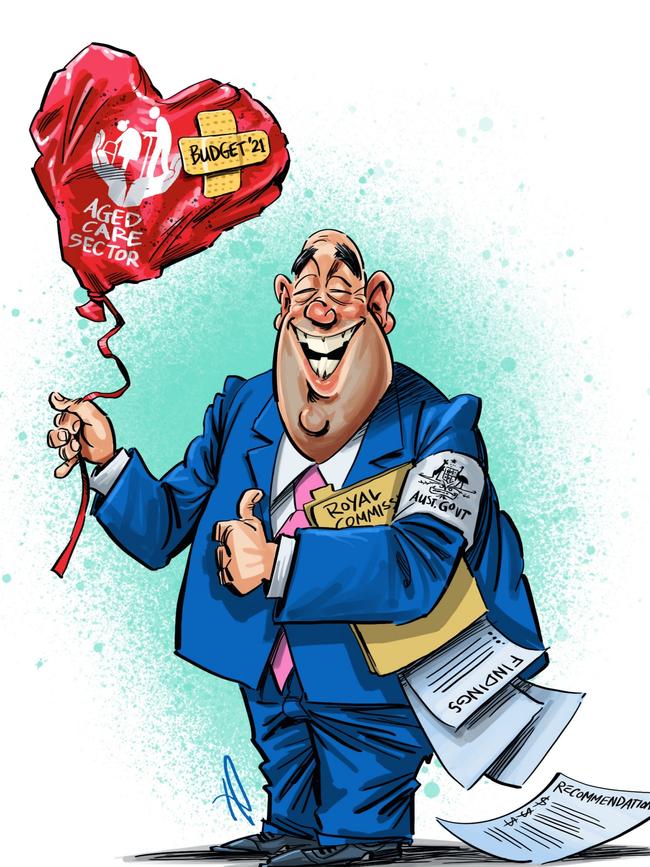Alan Jones: Aged care cash will barely touch the sides
There was a lot of cash splashed about in the federal budget last week, but not enough of it went to one of our most vital areas in aged care, writes Alan Jones.

Opinion
Don't miss out on the headlines from Opinion. Followed categories will be added to My News.
In the reams of paper that have been spent documenting and analysing the budget, one group of people — the aged, the frail and the infirmed — are rarely heard.
Admittedly, the government has provided $17.7 billion over five years to the aged care sector. The trouble is, the backlog of neglect is such that this amount will barely touch the sides. There has been a Royal Commission into all of this, with the final report brought down in February with 148 recommendations.
To improve the quality of care, the Prime Minister said, following the Royal Commission, that his government will offer a “comprehensive response”. I believe he was sincere.
Many would argue that $17.7 billion, over five years, is fairly comprehensive. The trouble is, much more than this will be needed to address what the Royal Commission called, “substandard care and abuse pervading the Australian aged care system”.

The Royal Commission found at least one in three aged care residents had suffered “substandard care”; one in five had been assaulted, prompting the report to state: “This is a disgrace and should be a source of national shame … older people receiving aged care should be safe and free from abuse at all times … there is a clear overuse of physical and chemical restraint in residential aged care”.
The Royal Commission report also revealed that many nursing home residents were malnourished and left to sit in their own faeces, like babies, because staff were too busy to take them to the toilet.
The report found the aged care system is “understaffed” and the workforce were “underpaid and under-trained”. This is more than a $17.7 billion-over-five-years crisis.
The Royal Commission found that half the elderly people living in nursing homes had dementia, yet “we are deeply concerned that so many aged-care providers don’t seem to have the skills or capacity required to care adequately for people living with dementia”.

But something has to give here because, by 2050, it’s estimated that one million Australians will be employed in aged care, yet the entry level pay for an aged care worker is $21.09 an hour, lower than for a supermarket shelf stacker.
In fact, workers in aged care are being paid $15 an hour less than an equivalent carer in the disability sector. On top of the issue of residents in aged care, there is the question of home care.
One of the key recommendations of the Royal Commission was that people be allowed to stay in their homes longer and receive care there, if they choose, rather than moving into a residential facility.
But in 2019, we were told that almost 30,000 older Australians died or were forced into an aged care home while waiting to be approved for home care packages, which are taxpayer funded.
The Royal Commission found that more than 44 seniors a day, over 16,000 a year, died waiting for their home care package; and the average waiting time for in-home care is 14 months.

A report on staffing levels commissioned by the Aged Care Royal Commission found 57.6 per cent of residents are in homes with staffing that would rate only one or two stars.
The sector needs extra staff and better pay, but that requires money.
The coronavirus deaths, in NSW and Victoria in aged care facilities, verify one conclusion of the Royal Commission that there were failures in clinical care and injection control which resulted in hundreds of deaths.
There are almost 200,000 residents in almost 3000 aged care homes on any one day.
These homes are operated by 873 aged care providers, ranging from listed public companies to a single facility small businesses.
Families pay enormous amounts of money to gain access to residential aged care. They write to me and say that all they bought for their money was death for their loved ones.
In September last year, the advocacy group Aged Care Crisis said: “Aged care residents in nursing homes have been raped, robbed, bathed in kerosene, attacked by rodents, suffered injuries and death from other residents, burned to death, strangled, cooked, melted, sedated to death, over-medicated or choked to death.”

This is more than a crisis, it’s a scandal. The decency of society must always be measured by our treatment of those who need our help most.
During the coronavirus, the government found over $100 billion for JobKeeper, for many people who shouldn’t have been put out of work in the first place; and we have a proposal to build submarines, which will cost well over $100 billion; and we tip a billion dollars into a Clean Energy Finance Corporation. I wonder if the public would prioritise those over aged care.
In relation to home care, it is acknowledged the backlog is greater than 80,000, but the budget says it will provide $6.5 million for 80,000 packages over the next two years.
That’s not what the Royal Commission recommended.
The government’s own Aged Care Financing Authority (who knows that these bureaucracies even exist) showed a deficit for residential care providers in the financial year 2018 of $102 million and financial year 2019 of $276 million.
Yet, when we are asking for better care and better pay, we are asking providers who are already on the brink of insolvency to stump up the money, money which doesn’t exist.
The reality is that the industry itself is fragile and almost insolvent, currently experiencing an aggregate negative return.

The aged care industry has a major liquidity threat. The banks are increasingly risk-averse and are reluctant to increase their liquidity funding.
Some 58 per cent of operations are making a loss; 56 per cent of operators in major cities, 60 per cent in inner-regional settings and a staggering 62 per cent in outer- regional rural and remote settings are operating at a loss.
Put another way, according to the government’s own figures, the aggregate operating result for the residential care sector was a deficit of $8.14 per bed per day, $2746 per bed per annum.
Between 1999-2000 and 2018-2019, the care costs for approved providers increased by 116.9 per cent but the subsidy level increased by only 70.3 per cent.
There is a yawning and unsustainable gap between the care revenue and the care costs.
The budget was clear to talk about increasing the average care minutes for each resident; stronger clinical care standards to support better dementia; and up to 6000 new personal care workers.
But who is going to pay for these, let alone pay for them properly?
If the government can find over $100 billion to keep people in jobs, what money should be found to keep people alive in aged care?
We are a long way from reaching a solution to the problems in a sector that the bulk of Australians will, one day, inhabit.





